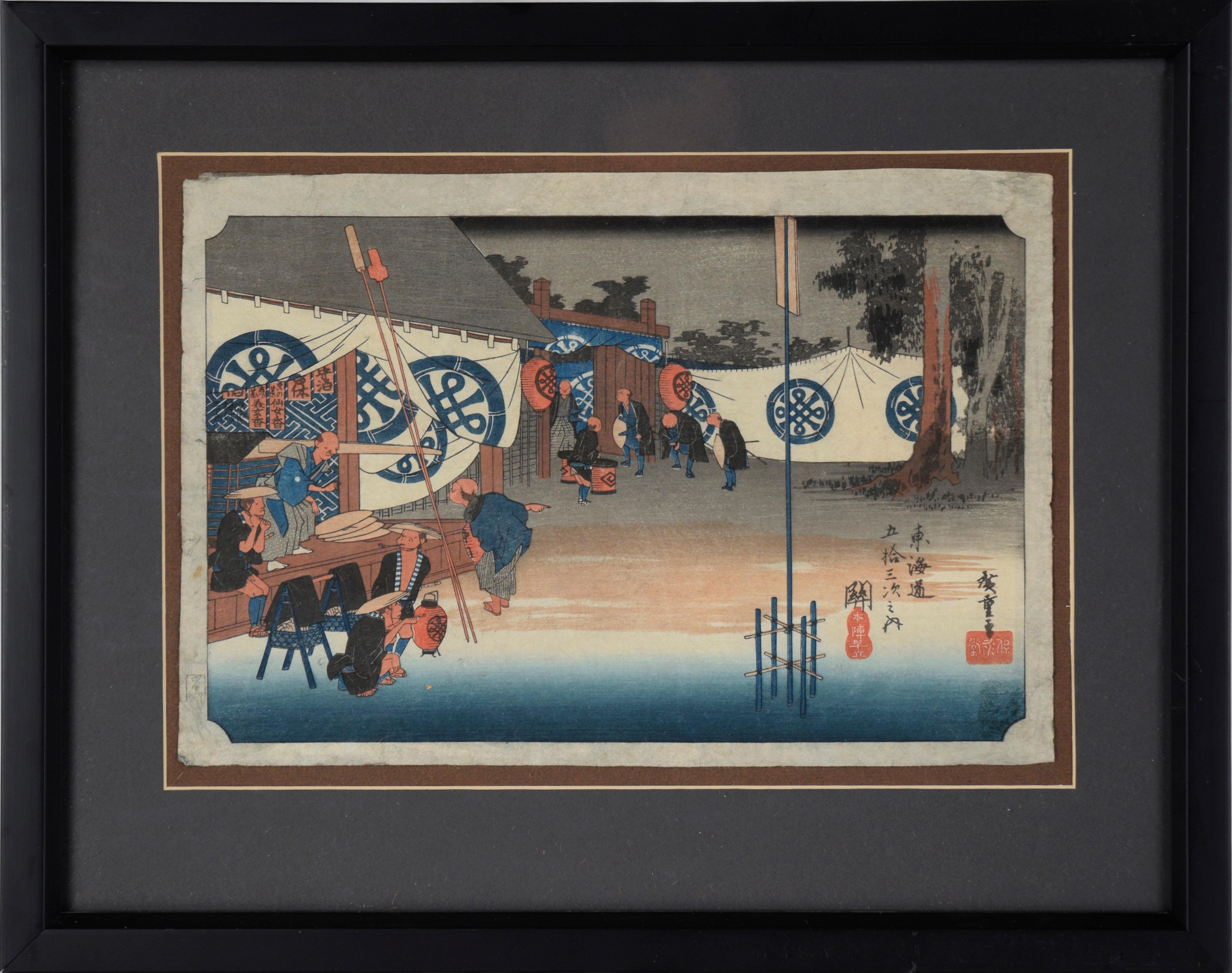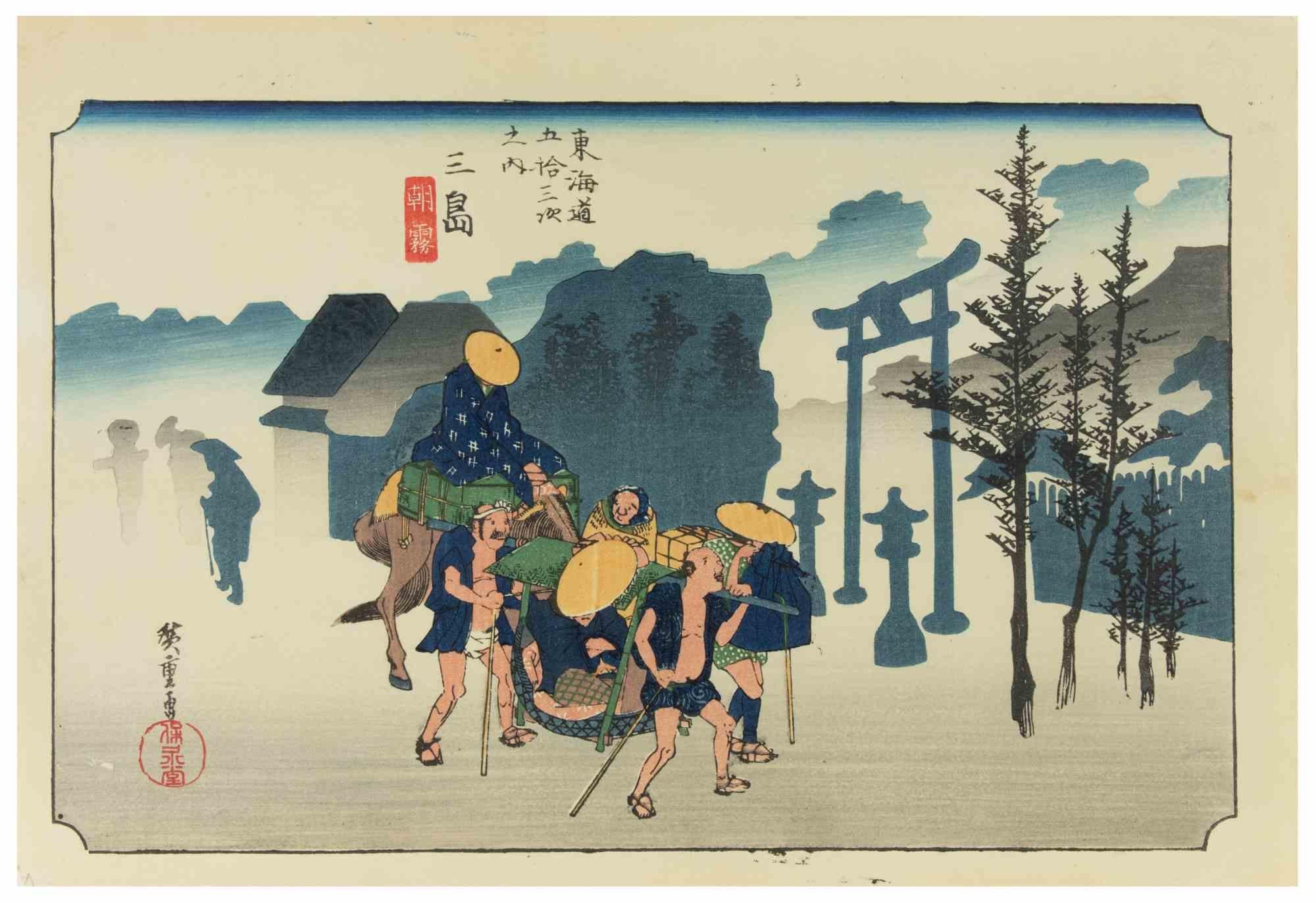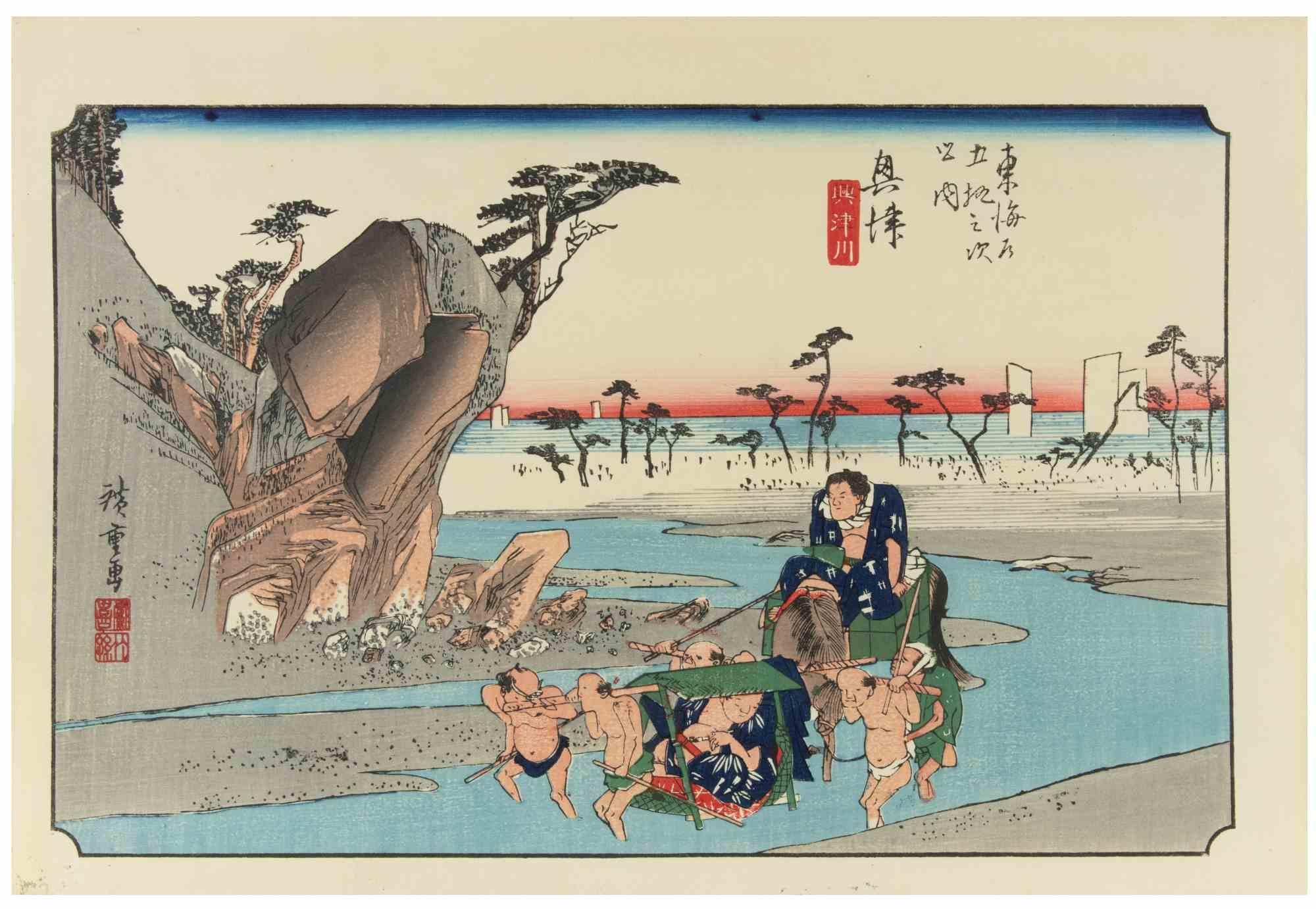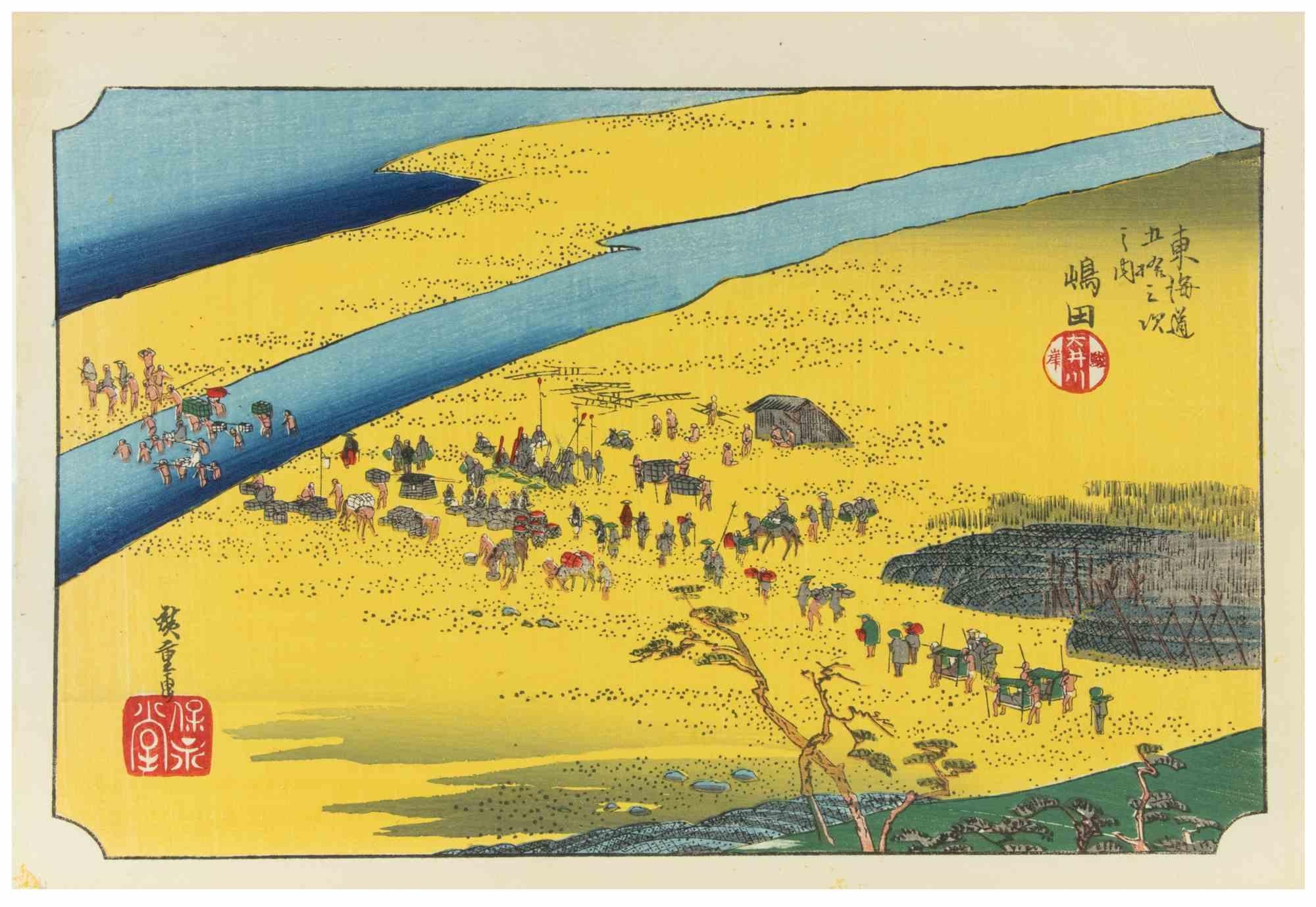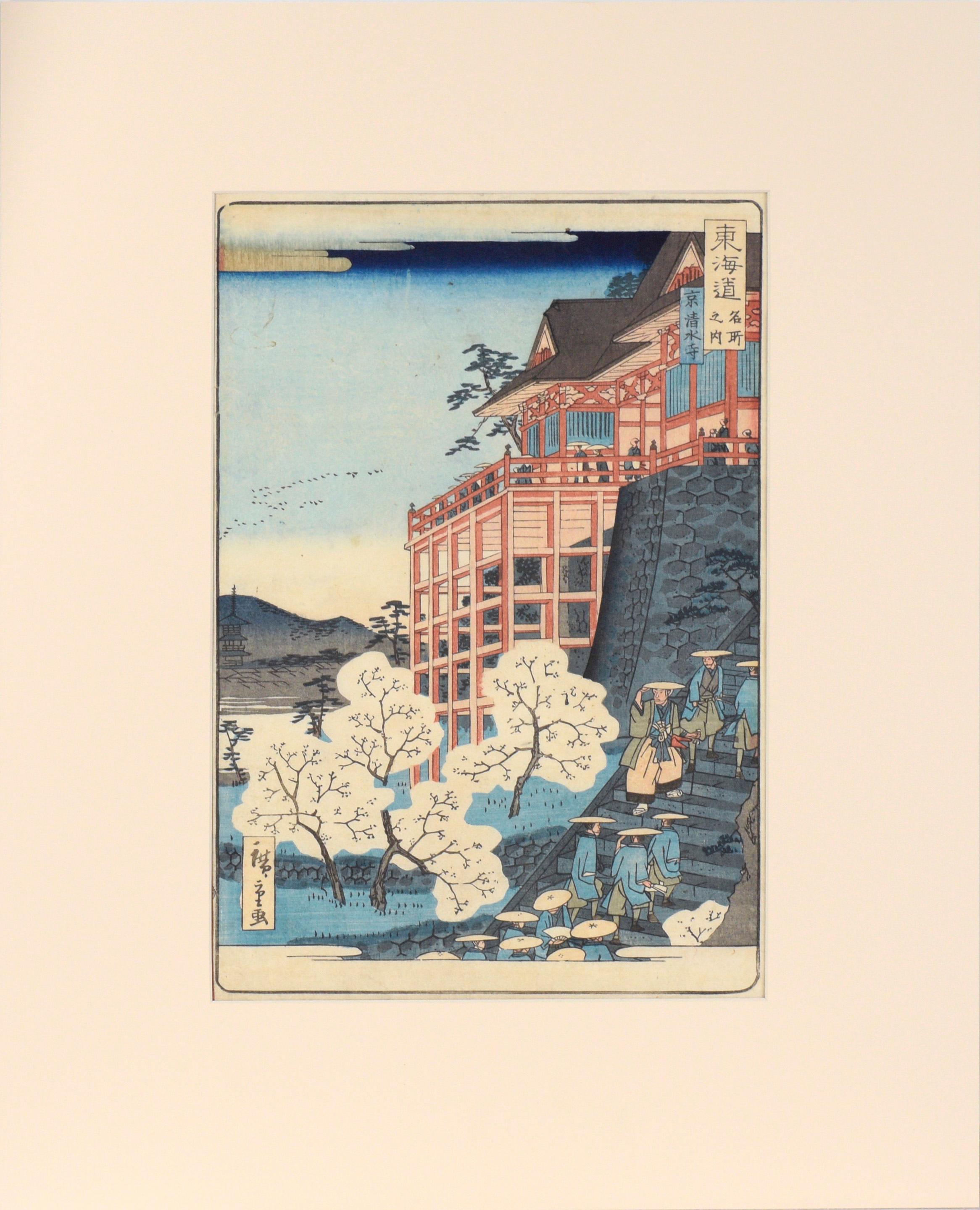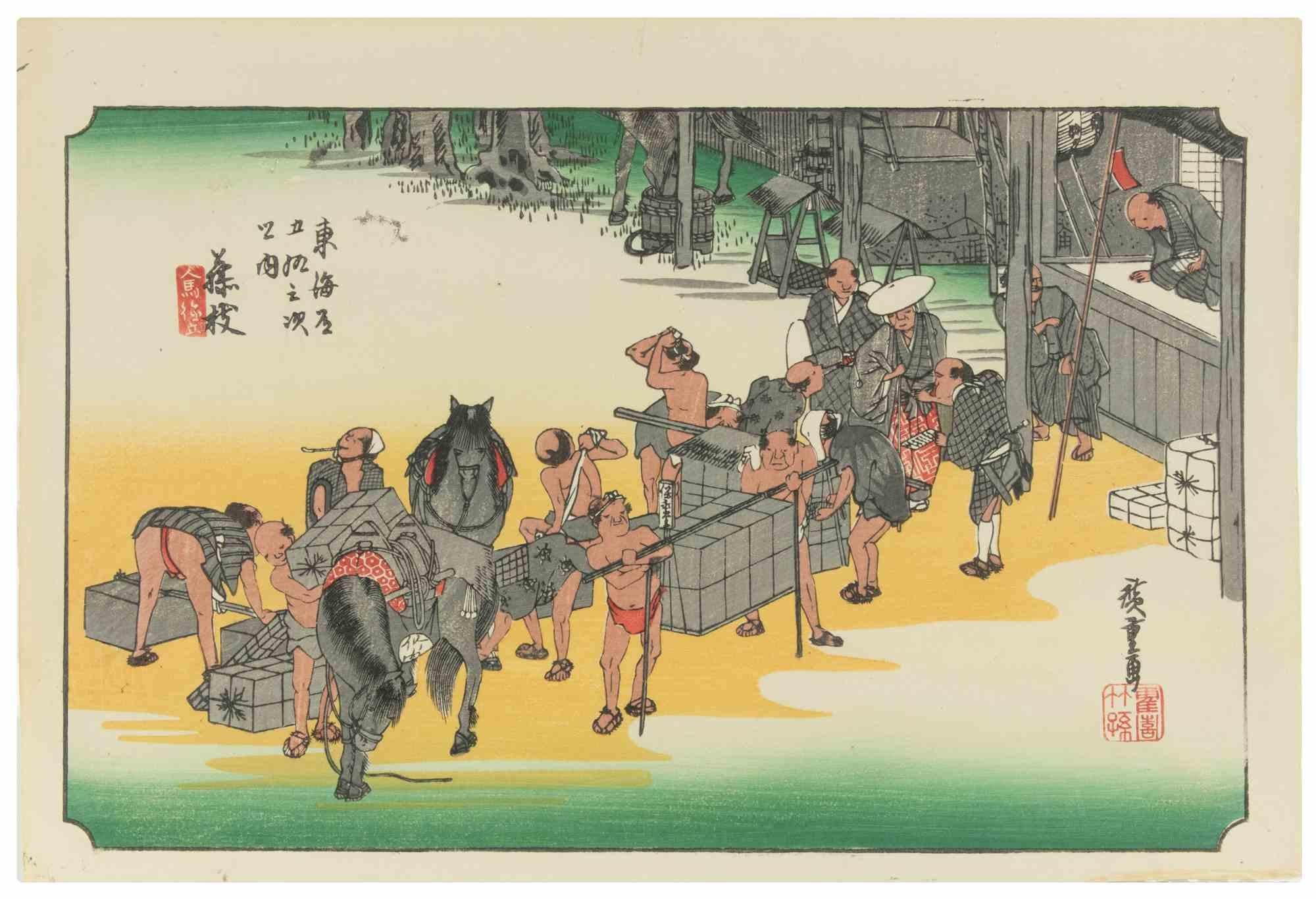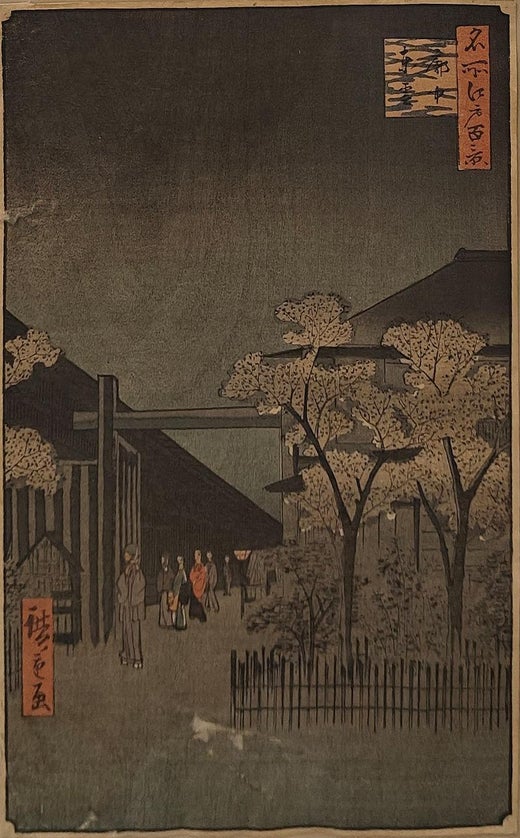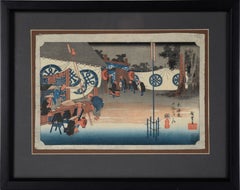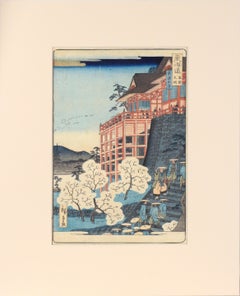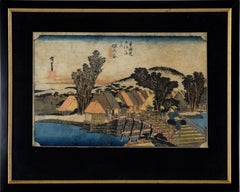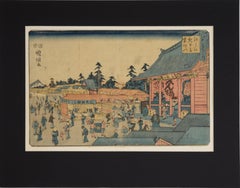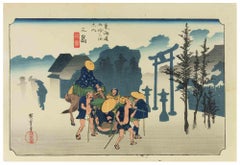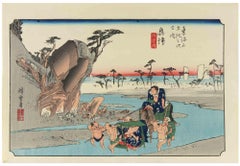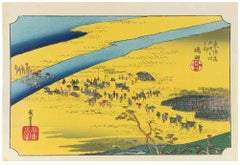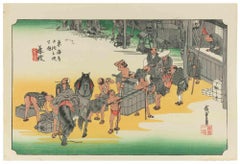Items Similar to Sumiyoshi: Dengaku dance performed during an Onda ceremony - Woodblock Print
Want more images or videos?
Request additional images or videos from the seller
1 of 12
Utagawa HiroshigeSumiyoshi: Dengaku dance performed during an Onda ceremony - Woodblock Printc. 1834
c. 1834
$680
$85020% Off
£504.86
£631.0820% Off
€588.31
€735.3820% Off
CA$944.06
CA$1,180.0720% Off
A$1,055.99
A$1,319.9920% Off
CHF 549.54
CHF 686.9320% Off
MX$12,999.60
MX$16,249.5020% Off
NOK 6,991.33
NOK 8,739.1620% Off
SEK 6,559.25
SEK 8,199.0620% Off
DKK 4,389.34
DKK 5,486.6820% Off
Shipping
Retrieving quote...The 1stDibs Promise:
Authenticity Guarantee,
Money-Back Guarantee,
24-Hour Cancellation
About the Item
Sumiyoshi: Dengaku dance performed during an Onda ceremony - Woodblock Print
Bright woodblock print by Utagawa Hiroshige (Japanese, 1797-1858). In this scene, two dancers with swords and fans are facing each other, in the center of a courtyard. There are spectators surrounding them, including nobles in black clothing on a balcony.
Presented in a new off-white mat with foamcore backing.
Mat size: 16"H x 20"W
Paper size: 9.63"H x 14.5W"
Utagawa Hiroshige (1797-1858, sometimes called Ando Hiroshige) was the second of the two great masters of the Japanese landscape woodblock print, after Hokusai. He is particularly known for his scenes featuring snow and rain, which feauture in many of his best and most famous images, and which has led to his becoming know as "the artist of rain, snow and mist".
He was born (with the name Ando Tokutaro) in Edo (the name of Tokyo at that point in time), and originally was intended to follow the career of his father, a fire-watchman. After his parents' death in 1809, the orphan Hiroshige gravitated toward the art world, an inclination which had been encouraged by his father.
In 1811, he became a pupil of the woodblock artist Toyohiro, who had been a fellow-pupil with the great woodblock master Tokokuni under Toyoharu (all of the Utagawa school, the latter being the founder). In 1812 he was formally adopted into the Utagawa school, with the name Utagawa Hiroshige. He continued to hold his post as a fire-watchman, though, until 1823.
His early prints from the period 1818-1830 were initially book illustrations, and later mostly actor prints and bijin-ga, all in the classic Utagawa school style, created by such masters of the Utagawa school as Toyokuni.
In the early 1830's, he started to discover himself as an artist, starting on the landscapes which became his forte, and changing his signature to Ichiyusai (sometimes Ichiryusai). His first landscape series was in 1829 or 1830, entitled Eight Famous Views of Omi, followed by a ten-print series Famous Places of the Eastern Capital, which in addition to showing the influence of Hokusai, also marked the first revelations of Hiroshige's true genius.
In 1832 he made his first journey down the Tokaido highway, which resulting in his first great artistic success, the original Fifty-Three Stations of the Tokaido, a series which catapulted him to contemporary fame and success. This series is is now also universally held among the greatest of all Japanese landscape prints, and one of the two best series he ever did.
For the next twenty years, he continued to produce large numbers of landscape and other series, but principally landscapes, on a large number of different themes.
Chief among them are a large number of other Tokaido series, among them so-called Gyosho Tokaido, the Reisho Tokaido and the Upright Tokaido. Hiroshige returned to the theme of the 53 stations again and again, producing a total of (by various countings) between 16 and 19 editions in all.
Two of the best series on this theme are the so-called "Gyosho Tokaido" (~1840, named after the cursive style of calligraphy used in the title cartouches, literally 'grass style') and the Reisho Tokaido (1848-1854, named after the scribes' style of calligraphy), although the latter is rare, since the blocks for it were destroyed in a fire when only a few prints had been made. Also found fairly often, and of some artistic note, is the so-called Upright Tokaido (1855, in which the print is oriented in portrait mode (or tateban), not landscape (or yokoban), as are the other three series above).
A more complete list of the various print series of Hiroshige, with references to the lists of titles and descriptions of individual prints is in The Colour Prints of Hiroshige by Edward F. Strange.
He lived his entire life in Edo, until his death from cholera at the age of 62 in 1858.
His life is best summed up by Edward F. Strange: "Outside his own little circle of friends and customers Hiroshige was a man of small importance in Japan. The cultured classes knew him not; and it is only since his work has begun to gain its great and growing reputation in Europe and America, that he is beginning to be appreciated in his own country."
- Creator:Utagawa Hiroshige (1797)
- Creation Year:c. 1834
- Dimensions:Height: 16 in (40.64 cm)Width: 20 in (50.8 cm)Depth: 0.25 in (6.35 mm)
- Medium:
- Movement & Style:
- Period:
- Condition:Ink is vibrant. Some tonal ageing to paper. Some isolated areas of staining.
- Gallery Location:Soquel, CA
- Reference Number:Seller: DBH90731stDibs: LU54214061262
Utagawa Hiroshige
Utagawa Hiroshige (1797 - 1858) was a Japanese ukiyo-e artist, considered the last great master of that tradition. Hiroshige is best known for his horizontal-format landscape series The Fifty-three Stations of the Tōkaidō and for his vertical-format landscape series One Hundred Famous Views of Edo. The subjects of his work were atypical of the ukiyo-e genre, whose typical focus was on beautiful women, popular actors, and other scenes of the urban pleasure districts of Japan's Edo period (1603–1868). The popular series Thirty-six Views of Mount Fuji by Hokusai was a strong influence on Hiroshige's choice of subject, though Hiroshige's approach was more poetic and ambient than Hokusai's bolder, more formal prints. Subtle use of color was essential in Hiroshige's prints, often printed with multiple impressions in the same area and with extensive use of bokashi (color gradation), both of which were rather labor-intensive techniques. For scholars and collectors, Hiroshige's death marked the beginning of a rapid decline in the ukiyo-e genre, especially in the face of the westernization that followed the Meiji Restoration of 1868. Hiroshige's work came to have a marked influence on Western painting towards the close of the 19th century as a part of the trend in Japonism. Western artists, such as Manet and Monet, collected and closely studied Hiroshige's compositions. Vincent van Gogh even went so far as to paint copies of two of Hiroshige's prints from One Hundred Famous Views of Edo.
About the Seller
5.0
Platinum Seller
Premium sellers with a 4.7+ rating and 24-hour response times
Established in 1986
1stDibs seller since 2014
2,943 sales on 1stDibs
Typical response time: <1 hour
- ShippingRetrieving quote...Shipping from: Soquel, CA
- Return Policy
Authenticity Guarantee
In the unlikely event there’s an issue with an item’s authenticity, contact us within 1 year for a full refund. DetailsMoney-Back Guarantee
If your item is not as described, is damaged in transit, or does not arrive, contact us within 7 days for a full refund. Details24-Hour Cancellation
You have a 24-hour grace period in which to reconsider your purchase, with no questions asked.Vetted Professional Sellers
Our world-class sellers must adhere to strict standards for service and quality, maintaining the integrity of our listings.Price-Match Guarantee
If you find that a seller listed the same item for a lower price elsewhere, we’ll match it.Trusted Global Delivery
Our best-in-class carrier network provides specialized shipping options worldwide, including custom delivery.More From This Seller
View AllStage 48 of the 53 Stages of the Tokaido - Japanese Woodblock on Rice Paper
By Utagawa Hiroshige
Located in Soquel, CA
Stage 48 of the 53 Stages of the Tokaido - Japanese Woodblock on Rice Paper
Woodblock print of clothing vendors by Utagawa Hiroshige (Japanese, 1797-1858). Originally printed in 183...
Category
1830s Impressionist Figurative Prints
Materials
Rice Paper, Woodcut
Kiyomizu Temple, Scenes of Famous Places along Tôkaidô Road - Woodblock on Paper
By Utagawa Hiroshige II
Located in Soquel, CA
Kiyomizu Temple, Scenes of Famous Places along Tôkaidô Road - Woodblock on Paper
Full Title:
Kyoto: Kiyomizu Temple (Kyô Kiyomizudera), from the series Scenes of Famous Places along...
Category
1860s Edo Landscape Prints
Materials
Ink, Rice Paper, Woodcut
Shin-machi Bridge at Hodogaya - Japanese Woodcut Print on Rice Paper
By Utagawa Hiroshige
Located in Soquel, CA
Shin-machi Bridge at Hodogaya - Japanese Woodcut Print on Rice Paper
Woodblock print of travelers on a bridge by Utagawa Hiroshige (Japanese, 1797-185...
Category
1850s Impressionist Figurative Prints
Materials
Rice Paper, Woodcut
$1,240 Sale Price
20% Off
"The Kaminarimon at the Kanseon Temple in Asakusa" - Original Japanese Print
Located in Soquel, CA
"The Kaminarimon at the Kanseon Temple in Asakusa" - Original Japanese Print
Japanese Print "The Kaminarimon at the Kanseon Temple in Asakusa", from the series "Famous Places in Ed...
Category
1850s Showa Figurative Prints
Materials
Rice Paper, Woodcut
Kiyomi Barrier & Seiken Temple Near Okitsu- Japanese Woodcut Print on Rice Paper
By Utagawa Hiroshige
Located in Soquel, CA
Kiyomi Barrier & Seiken Temple Near Okitsu - Japanese Woodcut Print on Rice Paper
Woodblock print of boats in a harbor by Utagawa Hiroshige (Japanese, 1797-1858). Originally publish...
Category
1850s Impressionist Figurative Prints
Materials
Rice Paper, Woodcut
"Toy Horse Dance" Japanese Woodblock Triptych with Beauties and Mt Fuji
Located in Soquel, CA
"Toy Horse Dance" Japanese Woodblock Triptych with Beauties and Mt Fuji
Vibrant three-panel woodblock print by Utagawa Toyohiro (Japanese,...
Category
Early 20th Century Edo Figurative Prints
Materials
Ink, Rice Paper, Woodcut
You May Also Like
Asagiri - Woodcut by Utagawa Hiroshige - 1832
By Utagawa Hiroshige
Located in Roma, IT
Asagiri is a woodcut print realized by Utagawa Hiroshige in 1832.
It is part of the suite "The Fifty-three Stations of Tokaido".
Very good condition.
Category
1830s Modern Figurative Prints
Materials
Woodcut
$721 Sale Price
25% Off
Okitsu-gawa - Woodcut by Utagawa Hiroshige - 1832
By Utagawa Hiroshige
Located in Roma, IT
Okitsu-gawa is a woodcut print realized by Utagawa Hiroshige in 1832.
It is part of the suite "The Fifty-three Stations of the Tokaido - Okitsu".
Very good condition.
Category
1830s Modern Figurative Prints
Materials
Woodcut
$721 Sale Price
25% Off
Shimada - Woodcut by Utagawa Hiroshige - 1833
By Utagawa Hiroshige
Located in Roma, IT
Asagiri is a woodcut print realized by Utagawa Hiroshige in 1832.
It is part of the suite "The Fifty-three Stations of Tokaido".
Very good condition.
Category
1830s Modern Figurative Prints
Materials
Woodcut
$721 Sale Price
25% Off
Seki - Woodcut by Utagawa Hiroshige - 1833
By Utagawa Hiroshige
Located in Roma, IT
Seki is a woodcut print realized by Utagawa Hiroshige in 1833.
It is part of the suite "The Fifty-three Stations of Tokaido".
Very good condition.
Category
1830s Modern Figurative Prints
Materials
Woodcut
$721 Sale Price
25% Off
Hiroshige Utagawa, The Suruga District in Edo
By Utagawa Hiroshige
Located in Torino, IT
HIROSHIGE UTAGAWA I, Edo 1797 - 1858
The Suruga District in Edo (Tôto Suruga-chô), from the series Thirty-six Views of Mount Fuji (Fuji sanjûrokkei)
Nishiki-e. Color woodcut, signed...
Category
1850s Edo Landscape Prints
Materials
Woodcut
Oiso, Tora ga ame - Woodcut by Utagawa Hiroshige - 1832
By Utagawa Hiroshige
Located in Roma, IT
Oiso, Tora ga ame is a woodcut print realized by Utagawa Hiroshige in 1832.
It is part of the suite The Fifty-three Stations of the Tokaido - Oiso.
Very good condition.
Category
1830s Modern Figurative Prints
Materials
Woodcut
$721 Sale Price
25% Off
